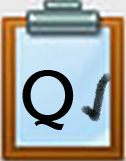Q1 What is a Social Network? My Own
What is a Social Network?
A social network can be both offline and online.
Online social networks occur when a community of individuals uses a website or social media resource (app or platform) to build relationships and communicate by sharing comments, images, videos, resources, etc. Online social networking requires using a digital device (phone, computer) to use social media apps and platforms such as Facebook, Instagram, Twitter, Snapchat, Pinterest, TikTok, and LinkedIn. These are a few of the reasons that social networking has become popular:
- Connecting with friends and family.
- Collaborative learning.
- Creative expression and information sharing.
Social Networking offline
Step 1. Consider this diagram of an OFFLINE social network of students who live in the same town.
 |
|
Step 2. Have a classroom discussion about:
- Without using a social network app or online resource, how would they all get to know each other?
- What would they need to do?
Step 3. You will also consider: Why Is Social Networking Popular? Continue the discussion from Step One.
Step 4. What are some other reasons people you know use social networking? Discuss this in your group or with your class.
My Social Network Activity
Step 1. For this activity, it may be helpful to consider some examples of Online and Offline Social Networking, which are available as an embedded slideshow below (Direct link to the slideshow) or in this PDF version.
Step 2. Then download or make a copy of 14.Q1 My Social Network Activity
Step 3. Complete the three parts of the activity. When done, check with your teacher about submitting your activity document.
Competencies & Standards
MITECS Michigan Integrated Technology Competencies for Students, and
1. Empowered Learner
a. Articulate and set personal learning goals when appropriate and to make choices on how to meet them, develop strategies using technology to achieve them and reflect on the learning process.
d. Understand the fundamental concepts (basics) of technology operations, demonstrate the ability to choose, use and troubleshoot current technologies and are able to transfer their knowledge to explore emerging technologies
Websites and Documents
21t4s Documents & Quizzes
- 14.Q1 My Social Network Activity
- 14.Q1 Social Networks in Society Online & Offline- slide deck; PDF version
- 14.Q1 Social Networking Over Time Activity




